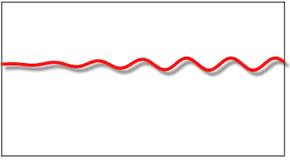These are good questions. There are many voice teachers who teach otherwise, but straight tone, not vibrato, is actually the most natural way to make a sound. Don’t let anyone tell you otherwise! You never hear a baby cry with vibrato, nor do people talk with vibrato (unless you count Katherine Hepburn). Vibrato must be consciously or unconsciously caused physically by the singer. Even instrumentalists cause vibrato either by mouth motions (embouchure vibrato), hand motions or conscious diaphragmatic pulsations.
For some singers, their musical ears tell them to sing with vibrato and their bodies react and respond, “kicking off” the muscle work to begin the vibrato. They might not even know how they’re making it happen! Singers without a vibrato, on the other hand, will have to make a more conscious effort to train their bodies to produce vibrato. Once the vibrato does begin, though, it soon becomes relatively easy to maintain,to the point we don’t really even think about it. It’s like when we learn to bike ride with our hands on the handle bars at first, but eventually we’re so comfortable with the balance that we can take our hands off of the handle bars with great control.
Vibrato isn’t natural until you can do it naturally. What do I mean by that? Well, I’ll make an analogy with hula-hooping. My oldest daughter and my son took to hula-hooping like ducks to water. After just one day, they knew how to hula-hoop for hours without stopping, and they looked like they were barely moving or even giving it any thought. They both routinely won the hula-hooping contests at school. Now me? I have to work really hard just to get the stupid thing to go around 4 or 5 times! But then, I also didn’t care to work that hard to learn, either. If I wanted to learn (and I lost a few pounds around the waist!) I know I could learn, but I’m not that motivated. Maybe in my retirement…
Ultimately vibrato feels natural, just like hula-hooping feels natural, easy and effortless, but only AFTER someone can do it. Some people find vibrato easily (like my kids with hula-hooping), others have to really experiment allot (like me with hula-hooping!). But anyone can learn, though the process may not look or sound pretty!
Let me give you this as a crude (and somewhat boring) example of what vibrato is:
It’s a bit like an air hose underwater, slowly letting air bubbles out at a consistent rate; say at 5-7 bubbles per second. Once one bubble is released, there is a little time for the air pressure to build back up, and then it releases the next bubble, and so on. In this example, of course, there is a complete break between each air bubble.
In singing, however, there is a constant, but uneven release of air. There is slightly more air pressure build-up than is being consistently released. As a result, there are periodic releases of that extra build up of air – the pulses that are part of the vibrato process. The extra back pressure before the release of each pulse, as small as it is, is felt all the way back in the lungs, and then it’s released. The vibrato sound we hear is the pressure-release-pressure-release pulsing that occurs, as well as the very slight regular compensatory instrument “wobble” that the pulses induce, and that the vocal cord stabilizer muscles have to, well… stabilize. Now, please understand that the “wobble” I’m talking about is not one that you should see, nor should a pitch wobble be heard, except at an almost indiscernible level. (Side note: most opera singers sing with very poor vibratos due to the extreme interval change with each pulse.
(Side note: most opera singers sing with very poor vibratos due to the extreme interval change with each pulse. Pitch changes of 1/2 step or more are all-too-common among many singers in both opera and black gospel singing styles. This is in no way to slight the musical styles of opera or black gospel. I am a lover of both styles when done well. The best singers in either of these styles do not have such “wide” vibratos, and have amazing voices.)
There is synergistic pressure build-up and release between the vocal folds (chords) and the muscles controlling the upward air flow (abs, diaphragm, and dozens of others). Also, just as our “core” muscle groups will stabilize us as we hula-hoop, the very small muscles stabilizing the vocal cords and larynx are both affected by, as well as affecting the pulsing. In other words, there is a synergistic relationship between momentum and causation. How’s that for boring?
But, at the end of the day, the vibrato process has to be “kicked off”, and then maintained by the singer. For many singers, their ear told them their tone needed a pulse to it, so they put it in, consciously or unconsciously. It’s frustrating to those who have to work at “causing” it to start, but it can be taught and it can definitely be learned. Once it’s learned well, it will feel “natural”.
I’ve worked with hundreds of students who had no vibrato. Every student with no vibrato that I’ve worked with has achieved a natural vibrato, as long as they practiced the assigned vibrato exercises consistently. Some had to work longer, but they got it. So will you.
Happy Singing!!
Eric Bruner
BecomeAVoiceTeacher.com
SingWithPower.com
Want to talk to me about voice lessons, the Voice Teacher Certification Program, or my self-study vocal training products? Click the “Live Chat” button now to talk to myself or my assistant.
I want to hear your ideas on vocal and singing topics for future posts and articles! Leave ideas in the reply box below…


